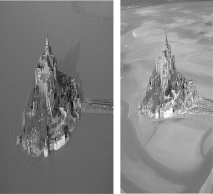Multiple Choice
Mt.Saint-Michel is separated from mainland Europe by approximately 1000 ft of relatively shallow water at high tide (as shown at left) ,but at low tide it is part of the wide,exposed intertidal zone (as shown at right) .What might you infer about the size the sediment clasts found on the exposed surface at low tide? 
A) The clasts are large because waves would remove small clasts.
B) The clasts are small because the wide, gently-sloped bottom would diminish wave strength, thus decreasing the waves' erosive power.
C) The clasts are large because the rough seas of the area routinely move large cobbles across the shallow bottom.
D) The clasts are salt particles that precipitate and grow when the tide is out and quickly dissolve when the tide comes in.
Correct Answer:

Verified
Correct Answer:
Verified
Q2: Rip currents flow _.<br>A)directly toward the shoreline<br>B)directly
Q3: When the sea level rises,the ocean may
Q25: Which type of coastline usually has a
Q43: What do you think the origin of
Q44: Major surface ocean currents travel _.<br>A) parallel
Q45: It is believed that global warming will
Q46: Black sand beaches are composed of _.<br>A)
Q48: What effect do most ocean waves have
Q50: Lagoons are richer in sand than barrier
Q51: The worldwide average tidal range (difference in